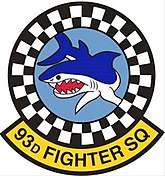93d Fighter Squadron
| 93rd Fighter Squadron | |
|---|---|
.jpg) A 93d Fighter Squadron F-16C Fighting Falcon in 2007
 | |
| Active | 1943–1946; 1949–1951; 1952–1957; 1978–present |
| Country |
|
| Branch |
|
| Role | Fighter |
| Part of | Air Force Reserve Command |
| Garrison/HQ | Homestead Air Reserve Base |
| Nickname(s) | Makos |
| Engagements |
Battle of Normandy Operation Market Garden Siege of Bastogne Operation Plunder[1] |
| Decorations |
Distinguished Unit Citation Air Force Outstanding Unit Award French Croix de Guerre with Palm[1] |
| Insignia | |
| 93d Fighter Squadron emblem (approved 11 June 1979)[1] |
 |
The 93d Fighter Squadron is part of the 482d Fighter Wing at Homestead Air Reserve Base, Florida. It operates the General Dynamics F-16 Fighting Falcon aircraft conducting air superiority missions.
History
World War II
Activated in June 1943 under I Troop Carrier Command and equipped with Douglas C-47 Skytrains. Trained in various parts of the eastern United States until the end of 1943. Deployed to England and assigned to IX Troop Carrier Command.
Prepared for the invasion of Nazi-occupied Europe. Began operations by dropping paratroops of the 101st Airborne Division in Normandy on D-Day (6 June 1944) and releasing gliders with reinforcements on the following day. The unit received a Distinguished Unit Citation and a French citation for these missions. After the Normandy invasion the squadron ferried supplies in the United Kingdom.
After moving to France in September, the unit dropped paratroops of the 82nd Airborne Division near Nijmegen and towed gliders carrying reinforcements during the airborne attack on the Netherlands. In December, it participated in the Battle of the Bulge by releasing gliders with supplies for the 101st Airborne Division near Bastogne.
When the Allies made the air assault across the Rhine River in March 1945, each aircraft towed two gliders with troops of the 17th Airborne Division and released them near Wesel. The squadron also hauled food, clothing, medicine, gasoline, ordnance equipment, and other supplies to the front lines and evacuated patients to rear zone hospitals. It converted from C-47s to C-46s and the new aircraft to transport displaced persons from Germany to France and Belgium after V-E Day.
Returned to the U.S. during the period July–September 1945, and trained with Curtiss C-46 Commando aircraft until inactivated.[1]
Air Force reserve
The squadron trained in troop carrier operations from, 1949–1951 and fighter-bomber operations from, 1952-1957. Since 1978, it has trained to maintain combat readiness in tactical fighter operations. The 93d periodically deployed to Turkey to enforce the no-fly zone over northern Iraq from, 1997-2003.[1]
Lineage
- Constituted as the 93d Troop Carrier Squadron on 14 May 1943
- Activated on 1 June 1943
- Inactivated on 10 June 1946
- Redesignated 93d Troop Carrier Squadron, Medium on 19 May 1949
- Activated in the reserve on 27 June 1949
- Ordered to active service on 1 April 1951
- Inactivated on 3 April 1951
- Redesignated 93d Fighter-Bomber Squadron on 26 May 1952
- Activated in the reserve on 15 June 1952
- Inactivated on 16 November 1957
- Redesignated 93d Tactical Fighter Squadron on 23 February 1978
- Activated in the Reserve on 1 October 1978
- Redesignated 93d Fighter Squadron on 1 February 1992[1]
Assignments
- 439th Troop Carrier Group, 1 June 1943 – 10 June 1946
- 439th Troop Carrier Group, 27 June 1949 – 3 April 1951
- 439th Fighter-Bomber Group, 15 June 1952 – 16 November 1957
- 915th Tactical Fighter Group, 1 October 1978
- 482d Tactical Fighter Wing (later 482d Fighter Wing), 1 April 1981
- 482d Operations Group, 1 August 1992 – present[1]
Stations
|
|
Aircraft
|
|
References
- Notes
Bibliography
![]()
- Anderson, Capt. Barry (1985). Army Air Forces Stations: A Guide to the Stations Where U.S. Army Air Forces Personnel Served in the United Kingdom During World War II (PDF). Maxwell AFB, AL yes: Research Division, USAF Historical Research Center. Archived from the original (PDF) on January 23, 2016. Retrieved June 28, 2017.
- Johnson, 1st Lt. David C. (1988). U.S. Army Air Forces Continental Airfields (ETO) D-Day to V-E Day (PDF). Maxwell AFB, AL: Research Division, USAF Historical Research Center. Archived from the original (PDF) on September 29, 2015. Retrieved June 26, 2017.
- Maurer, Maurer, ed. (1983) [1961]. Air Force Combat Units of World War II (PDF) (reprint ed.). Washington, DC: Office of Air Force History. ISBN 0-912799-02-1. LCCN 61060979. Retrieved December 17, 2016.
- Maurer, Maurer, ed. (1982) [1969]. Combat Squadrons of the Air Force, World War II (PDF) (reprint ed.). Washington, DC: Office of Air Force History. ISBN 0-405-12194-6. LCCN 70605402. OCLC 72556. Retrieved December 17, 2016.

.svg.png)